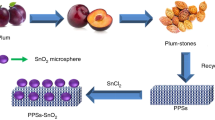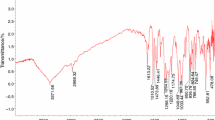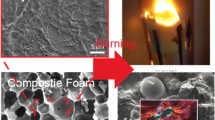Abstract
Novel porous carbon sheets were developed as green, renewable, cost-effective, and efficient flame retardant material for thermoplastic polymers. Renewable porous graphite sheets were directly obtained from one pot recycling process of agriculture bio-waste sugar beet leaves at low temperature and used as scalable and efficient flame retardant for polystyrene. Thus providing dual benefits to environment for recycling of harmful bio-waste and developing new scalable and efficient flame retardant. The developed renewable flame retardant has specific surface area of 214 m2 g−1 and average pore size of 2.1 nm in addition to natural doping of precious metal residues. The sustainable porous graphite sheets were dispersed well in polymer matrix and their mass loading was altered and optimized giving rise to different polymer composites. Furthermore, different mass loadings of magnesium hydroxide were incorporated with porous graphite sheets in polymer composite. The thermal stability and flammability measurements of developed polymer composites elucidated the significant improvement in fire safety and flame retardancy of developed polystyrene composites. Thus, the reduction in peak heat release rate (PHRR) and total heat release rate (THR) of polymer composites were found to be 62 and 48%, respectively. This is in addition to a significant reduction in rate of burning and improvement in limiting oxygen index (LOI) value achieving reduction and improvement by 84 and 33%, respectively. Additionally, excellent suppression of emission of CO2 and CO gases was recorded (~ 40%). The outstanding flame retardancy and toxic gases suppression effect of developed porous graphite sheets was attributed to its charring capability and porous structure effect in conjunction to natural doping of desirable elemental composition. This study presents a new tool for production of scalable, green, renewable, and cost-effective flame retardant and smoke suppressant materials for thermoplastic polymers.
Graphical abstract








Similar content being viewed by others
References
Shi Y, Liu C, Fu L, Yang F, Lv Y, Yu B. Hierarchical assembly of polystyrene/graphitic carbon nitride/reduced graphene oxide nanocomposites toward high fire safety. Compos Part B. 2019;179:107541.
Attia NF, Zayed M. Nanoparticles decorated on resin particles and their flame retardancy behavior for polymer composites. J Nanomaterials. 2017;2017:1–8.
Kiliaris P, Papaspyrides CD. Polymer/layered silicate (clay) nanocomposites: an overview of flame retardancy. Prog Polym Sci. 2010;35:902–58.
Tai Q, Chen L, Song L, Nie S, Hu Y, Yuen RKK. Preparation and thermal properties of a novel flame retardant copolymer. Polym Degrad Stab. 2010;95:830–6.
Bao C, Song L, Wilkie CA, Yuan B, Guo Y, Hu Y, Gong X. Graphite oxide, graphene, and metal-loaded graphene for fire safety applications of polystyrene. J Mater Chem. 2012;22:16399–406.
Kong Q, Lu H, Chen Z, Fan W. Synthesis and properties of polystyrene/Fe- montmorillonite nanocomposites using synthetic Fe-montmorillonite by bulk polymerization. J Mater Sci. 2005;40:4505–9.
Li J, Ke C, Xu L, Wang Y. Synergistic effect between a hyperbranched charring agent and ammonium polyphosphate on the intumescent flame retardance of acrylonitrile-butadiene styrene polymer. Polym Degrad Stab. 2012;97:1107.
Duan L, Yang H, Song L, Hou YB, Wang W, Gui Z, Hu Y. Hyperbranched phosphorus/nitrogen-containing polymer in combination with ammonium polyphosphate as a novel flame retardant system for polypropylene. Polym Degrad Stab. 2016;134:179–85.
Liu W, Wang D, Zhang Y, Bai T, Li J. Flammability and flame-retardant mechanism of high density polyethylene/wood fiber/modified ammonium polyphosphate composite. Polym Compos. 2018;39:1192–9.
Guo Z, Wang C, Li J. An intumescent-like flame-retardant effect of hollow carbon precursor on acrylonitrile–butadiene–styrene/oligomeric aryl phosphate/novolac epoxy composites. Polym-Plast Techno Eng. 2016;55:1441–9.
Xu B, Ma W, Wu X, Qian L, Jiang S. Flame retardancy and thermal behavior of intumescent flame-retardant EVA composites with an efficient triazine-based charring agent. Mater Res Express. 2018;5:045309.
Cao X, Yang Y, Luo H, Cai X. High efficiency intumescent flame retardancy between Hexakis (4-nitrophenoxy) cyclotriphosphazene and ammonium polyphosphate on ABS. Polym Degrad Stab. 2017;143:259–65.
Yew MC, Sulong NHR, Yew MK, Amalina MA, Johan MR. Influences of flame-retardant fillers on fire protection and mechanical properties of intumescent coating. Prog Org Coat. 2015;78:59–66.
Stretz HA, Wootan MW, Cassidy PE, Koo JH. Effect of exfoliation on poly(styrene-co-acrylonitrile)/montmorillonite nanocomposite flammability. Polym Adv Technol. 2005;16:239–48.
Du M, Guo B, Jia D. Thermal stability and flame retardant effects of halloysite nanotubes on poly (propylene). Euro Polym J. 2006;42:1362–9.
Attia NF, Hassan MA, Nour MA, Geckeler KE. Flame-retardant materials: synergistic effect of halloysite nanotubes on the flammability properties of acrylonitrilebutadiene-styrene composites. Polym Int. 2014;63:1168–73.
Laachachi A, Leroy E, Cochez M, Ferriol M, Lopez Cuesta JM. Use of oxide nanoparticles and organoclays to improve thermal stability and fire retardancy of poly(methyl methacrylate). Polym Degrad Stab. 2005;89:344–52.
Guan F-L, Gui C-X, Zhang H-B, Jiang Z-G, Jiang Y, Yu Z-Z. Enhanced thermal conductivity and satisfactory flame retardancy of epoxy/alumina composites by combination with graphene nanoplatelets and magnesium hydroxide. Compos Part B: Eng. 2016;98:134–40.
Attia NF, Abdel Eal NS, Hassan MA. Facile synthesis of graphene sheets decorated nanoparticles and flammability of their polymer nanocomposites. Polym Degrad Stab. 2016;126:65–79.
Wang D, Zhang QJ, Zhou K, Yang W, Hu Y, Xl G. The influence of manganese–cobalt oxide/graphene on reducing fire hazards of poly (butylene terephthalate). J Hazard Mater. 2014;278:391–400.
Attia NF. Organic nanoparticles as promising flame retardant materials for thermoplastic polymers. J Therm Anal Calor. 2017;127:2273.
Park J, Jung M, Jang H, Lee K, Attia NF, Oh H. A facile synthesis tool of nanoporous carbon for promising H2, CO2, and CH4 sorption capacity and selective gas separation. J Mater Chem A. 2018;6:23087.
Shi LZ, Yu B, Zhou K, Gui Z, Yuen RKK, Hu Y. Tunable thermal, flame retardant and toxic effluent suppression properties of polystyrene based on alternating graphitic carbon nitride and multi-walled carbon nanotubes. J Mater Chem A. 2015;3:17064–73.
Zhou K, Jiang S, Shi Y, Liu J, Wang B, Hu Y, Gui Z. Multigram-scale fabrication of organic modified MoS2 nanosheets dispersed in polystyrene with improved thermal stability, fire resistance, and smoke suppression properties. RSC Adv. 2014;4:40170–80.
Qiu S, Hu W, Yu B, Yuan B, Zhu Y, Jiang S, Wang B, Song L, Hu Y. Effect of functionalized graphene oxide with organophosphorus oligomer on the thermal and mechanical properties and fire Safety of polystyrene. Ind Eng Chem Res. 2015;54:3309–19.
Attia NF, Park J, Oh H. Facile tool for green synthesis of graphene sheets and their smart freestanding UV protective film. Appl Surf Sci. 2018;458:425–30.
Barrett EP, Joyner LS, Halenda PP. the determination of pore volume and area distributions in porous substances. I. Computations from nitrogen isotherms. J Am Chem Soc. 1951;73:373–80.
International standard IEC 60695-11-10, Fire hazard testing Part 11-10: test flames-50 W horizontal and vertical flame test methods
ISO 5660-1. Reaction-to-fire tests—heat release, smoke production and mass loss rate-part1: heat release rate (cone calorimeter method). Geneva, Switzerland: International Organization for Standardization, 2002
Kun Z, Yue Z, Shiren W. Enhancing thermoelectric properties of organic composites through hierarchical nanostructures. Sci Rep. 2013;3:3448.
Sing KSW, Everett DH, Haul RAW, Moscou L, Pierotti RA, Rouquerol J, Siemieniewska T. Pure Appl Chem. 1985;57:603–19.
Dittrich B, Wartig K-A, Mülhaupt R, Schartel B. Flame-retardancy properties of intumescent ammonium poly(phosphate) and mineral filler magnesium hydroxide in combination with graphene. Polymers. 2014;6:2875–95.
Hong N, Zhan J, Wang X, Stec AA, Hull TR, Ge H, Xing W, Song L, Hu Y. Enhanced mechanical thermal and flame retardant properties by combining graphene nanosheets and metal hydroxide nanorods for acrylonitrilebutadiene-styrene copolymer composites. Compos Part A Appl Sci Manfact. 2014;64:203–10.
Attia NF, Abdel Hady K, Elashery SEA, Hashem HM, Oh H, Refaat AM, Abdel Hady A. Greener synthesis route and characterization of smart hybrid graphene based thin films. Surf Inter. 2020;21:100681.
Dittrich B, Wartig K-A, Hofmann D, Mülhaupt R, Schartel B. Flame retardancy through carbon nanomaterials: carbon black, multiwall nanotubes, expanded graphite, multi-layer graphene and graphene in polypropylene. Polym Degrad Stab. 2013;98:1495–505.
Attia NF, Afifi HA, Hassan M. Synergistic study of carbon nanotubes, rice husk ash and flame retardant materials on the flammability of polystyrene nanocomposites. Mater Today: Proc. 2015;2:3998–4005.
Attia NF, Hegazi EM, Abdelmageed AA. Smart modification of inorganic fibers and flammability mechanical and radiation shielding properties of their rubber composites. J Therm Anal Calor. 2018;132:1567–78.
Wang Y, Qing Y, Sun Y, Zhu M, Dong S. A study on preparation of modified Graphene Oxide and flame retardancy of polystyrene composite microspheres. Desig Mono Polym. 2020;23:1–15.
Author information
Authors and Affiliations
Corresponding author
Additional information
Publisher's Note
Springer Nature remains neutral with regard to jurisdictional claims in published maps and institutional affiliations.
Supplementary Information
Below is the link to the electronic supplementary material.
Rights and permissions
About this article
Cite this article
Attia, N.F. Sustainable and efficient flame retardant materials for achieving high fire safety for polystyrene composites. J Therm Anal Calorim 147, 5733–5742 (2022). https://doi.org/10.1007/s10973-021-10948-3
Received:
Accepted:
Published:
Issue Date:
DOI: https://doi.org/10.1007/s10973-021-10948-3




